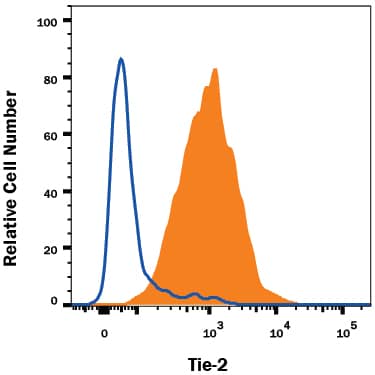Human Tie-2 PE-conjugated Antibody
R&D Systems, part of Bio-Techne | Catalog # FAB3131P


Key Product Details
Species Reactivity
Validated:
Cited:
Applications
Validated:
Cited:
Label
Antibody Source
Product Specifications
Immunogen
Ala23-Lys745
Accession # AAA61139
Specificity
Clonality
Host
Isotype
Scientific Data Images for Human Tie-2 PE-conjugated Antibody
Detection of Tie‑2 in HUVEC Human Cells by Flow Cytometry.
HUVEC human umbilical vein endothelial cells were stained with Mouse Anti-Human Tie-2 PE-conjugated Monoclonal Antibody (Catalog # FAB3131P, filled histogram) or isotype control antibody (Catalog # IC002P, open histogram). View our protocol for Staining Membrane-associated Proteins.Detection of Mouse Human Tie-2 PE-conjugated Antibody by Flow Cytometry
CSF1 up-regulates Tie2 receptor on CD14+ human monocytes.(A) CD14+ monocytes were isolated from whole blood using CD14+ microbeads. Cells were fixed and immunostained using anti-human Tie2 receptor antibody or isotype control antibody immediately following isolation (Freshly isolated) or after treated without (-CSF1) or with rhCSF1 (100 ng/ml) (+CSF1) for 24 hours. N = 10 per group and results represent the mean ± SEM of Tie2-positivity. (B) CD14+ monocytes treated with rhANG1 (100 ng/ml), rhANG2 (100 ng/ml) or a dose-response of rhCSF1 (0, 0.1, 1, 10, 100 ng/ml). ANG2 up-regulated Tie2 expression compared to ANG1 and CSF1 induces a dose-escalation of Tie2 on CD14+ monocytes. N = 10 per group and results represent the mean ± SEM of Tie2-positivity. (C) CD14+ monocytes were left untreated (Utx) or treated with rhANG2 (100 ng/ml) (ANG2), rhCSF1 (100 ng/ml) (CSF1), CSF1R neutralizing antibody alone, or pre-treated with the CSF1R Nab for 30 minutes prior to stimulation with rhCSF1 (100 ng/ml) (CSF1R NAb+CSF1) for 24 hours. ANG2- and CSF1-treatment significantly increased Tie2 expression while the CSF1R NAb abrogated this effect. N = 8 per group and results represent the mean ± SEM of Tie2-positivity by flow cytometry. (D) CD14+ monocytes were left untreated (Untreated), pre-treated with CSF1R NAb (40 µg or 80 µg) for 30 minutes then treated with rhCSF1 (100 ng/ml) (CSF1R NAb+CSF1), or with rhCSF1 (100 ng/ml) alone (CSF1) for 10 minutes. Western blot analysis indicates that the CSF1R NAb was effective at reducing Akt1 phosphorylation. Image collected and cropped by CiteAb from the following publication (https://pubmed.ncbi.nlm.nih.gov/24892425), licensed under a CC-BY license. Not internally tested by R&D Systems.Detection of Mouse Human Tie-2 PE-conjugated Antibody by Flow Cytometry
CSF1 up-regulates Tie2 receptor on CD14+ human monocytes.(A) CD14+ monocytes were isolated from whole blood using CD14+ microbeads. Cells were fixed and immunostained using anti-human Tie2 receptor antibody or isotype control antibody immediately following isolation (Freshly isolated) or after treated without (-CSF1) or with rhCSF1 (100 ng/ml) (+CSF1) for 24 hours. N = 10 per group and results represent the mean ± SEM of Tie2-positivity. (B) CD14+ monocytes treated with rhANG1 (100 ng/ml), rhANG2 (100 ng/ml) or a dose-response of rhCSF1 (0, 0.1, 1, 10, 100 ng/ml). ANG2 up-regulated Tie2 expression compared to ANG1 and CSF1 induces a dose-escalation of Tie2 on CD14+ monocytes. N = 10 per group and results represent the mean ± SEM of Tie2-positivity. (C) CD14+ monocytes were left untreated (Utx) or treated with rhANG2 (100 ng/ml) (ANG2), rhCSF1 (100 ng/ml) (CSF1), CSF1R neutralizing antibody alone, or pre-treated with the CSF1R Nab for 30 minutes prior to stimulation with rhCSF1 (100 ng/ml) (CSF1R NAb+CSF1) for 24 hours. ANG2- and CSF1-treatment significantly increased Tie2 expression while the CSF1R NAb abrogated this effect. N = 8 per group and results represent the mean ± SEM of Tie2-positivity by flow cytometry. (D) CD14+ monocytes were left untreated (Untreated), pre-treated with CSF1R NAb (40 µg or 80 µg) for 30 minutes then treated with rhCSF1 (100 ng/ml) (CSF1R NAb+CSF1), or with rhCSF1 (100 ng/ml) alone (CSF1) for 10 minutes. Western blot analysis indicates that the CSF1R NAb was effective at reducing Akt1 phosphorylation. Image collected and cropped by CiteAb from the following publication (https://pubmed.ncbi.nlm.nih.gov/24892425), licensed under a CC-BY license. Not internally tested by R&D Systems.Applications for Human Tie-2 PE-conjugated Antibody
Flow Cytometry
Sample: HUVEC human umbilical vein endothelial cells
Reviewed Applications
Read 2 reviews rated 4 using FAB3131P in the following applications:
Formulation, Preparation, and Storage
Purification
Formulation
Shipping
Stability & Storage
- 12 months from date of receipt, 2 to 8 °C as supplied.
Background: Tie-2
Tie-1/Tie (tyrosine kinase with Ig and EGF homology domains 1) and Tie-2/Tek comprise a receptor tyrosine kinase (RTK) subfamily with unique structural characteristics: two immunoglobulin-like domains flanking three epidermal growth factor (EGF)-like domains and followed by three fibronectin type III-like repeats in the extracellular region and a split tyrosine kinase domain in the cytoplasmic region. These receptors are expressed primarily on endothelial and hematopoietic progenitor cells and play critical roles in angiogenesis, vasculogenesis and hematopoiesis.
Human Tie-2 cDNA encodes a 1124 amino acid (aa) residue precursor protein with an 18 residue putative signal peptide, a 727 residue extracellular domain and a 354 residue cytoplasmic domain. Two ligands, angiopoietin-1 (Ang-1) and angiopoietin-2 (Ang-2), which bind Tie-2 with high-affinity have been identified. Ang-2 has been reported to act as an antagonist for Ang-1. Mice engineered to overexpress Ang-2 or to lack Ang-1 or Tie-2 display similar angiogenesis defects.
References
- Partanen, J. and D.J. Dumont (1999) Curr. Top. Microbiol. Immunol. 237:159.
- Takakura, N. et al. (1998) Immunity 9:677.
- Procopio, W. et al. (1999) J. Biol. Chem. 274:30196.
Long Name
Alternate Names
Entrez Gene IDs
Gene Symbol
UniProt
Additional Tie-2 Products
Product Documents for Human Tie-2 PE-conjugated Antibody
Product Specific Notices for Human Tie-2 PE-conjugated Antibody
For research use only

